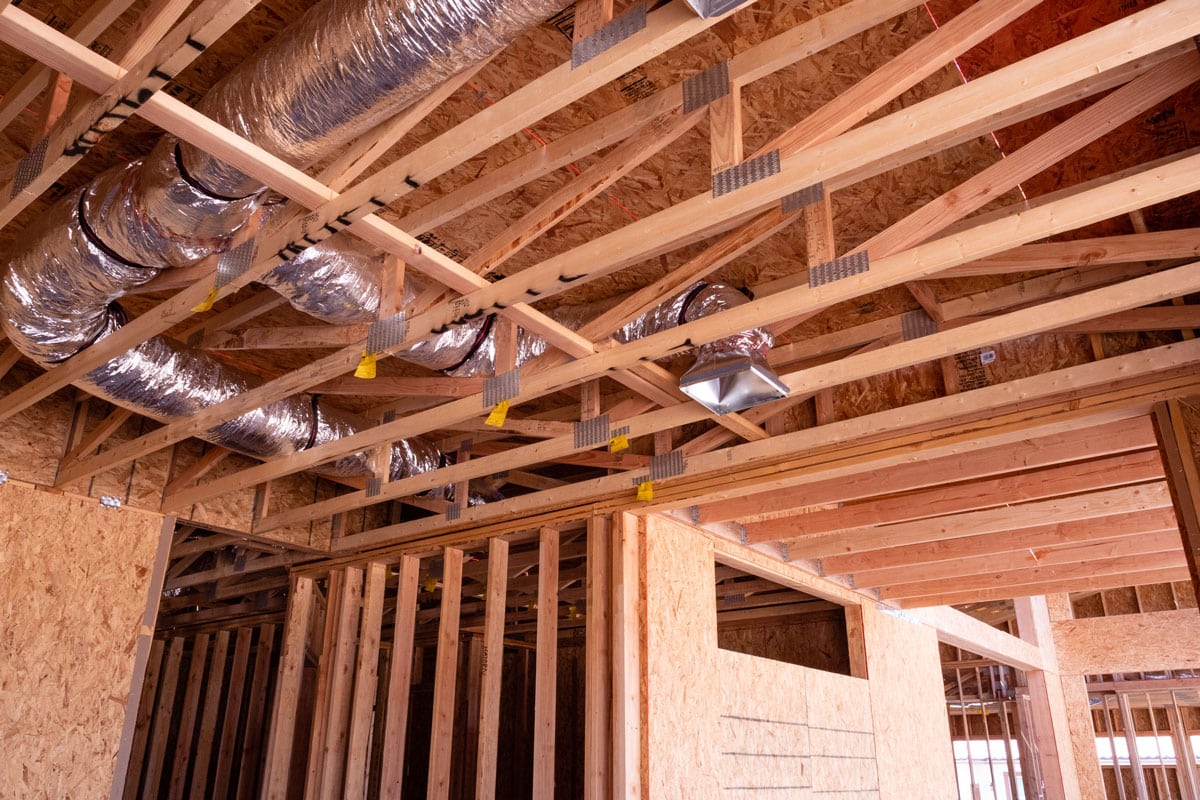If you're planning the duct layout of your home's ventilation, you may need to know the maximum duct lengths for the exhaust fans. We researched this topic to bring you the correct information, and here's what we discovered.
The maximum length of extractor ducting depends on the type of exhaust fan installed at its inlet. For axial fans, ducts run up to 4.9 feet. For centrifugal fans, the duct can run up to about 20 feet.
Extractor ducting directs unwanted air out of your home. In this post, we'll cover duct lengths, what exhaust fan to use, ducting material, and other related topics. Stay on this page as we dig deep into every stage of the ducting process. Keep reading!
.

How Long Should Extractor Ducting Be?
A ventilation system isn't complete without extractor ducting, which directs damp air and pollutants out of your home. To achieve this, the extractor ducts work with exhaust fans.
The length of the extractor ducting depends on whether you will use axial or centrifugal fans for the ducting inlets. Ducting length impacts fan performance, so you need to know which fan type best suits your home's ventilation requirements.
Axial Fans

An axial fan is a low-pressure fan with fan blades similar to a ship propeller. The blades revolve on only one axis, so the movement of air is in a single direction. As a rule of thumb, 4.9 feet of ducting should be used with this type of fan. Flexible ducts are typically used.
The motor of an axial fan can move a large volume of air through low pressure. This low-pressure air justifies its need for a short duct run. An extraction rate of 264 m3/hr is considered suitable for a 6-inch ducting diameter.
In most homes, axial fans are appropriate when ducting through a wall directly connected to an external vent. It also serves as the exhaust for enclosed spaces such as bathrooms and garages.


Check out this axial fan on Amazon.
Centrifugal Fans

If you're considering ducting more than 4.9 feet, a centrifugal fan is needed. With blades similar to a hamster wheel, this fan creates a high-pressure airstream. Centrifugal fans perform better with long sections of ducting, but no more than about 20 feet.
Centrifugal fans, also called blowers, provide a higher level of performance than regular exhaust fans. With a centrifugal motor, the extraction rate can be over 460 m3/hr.
Some centrifugal fan models can be ceiling mounted. Homeowners greatly benefit from this feature due to its discrete design, aside from space-saving and ease of installation.
Centrifugal fans are also best for exposed installations. The fan's capabilities are far superior, and pressure loss is minimal even with long duct runs.


Check out this centrifugal fan on Amazon.
Axial vs. Centrifugal: Which To Choose
When deciding which type of exhaust fan to use for your living space, you need to make a few factors. Here are a some points to consider:
An axial fan:
- The motor moves larger air volumes, but with low air pressure.
- Is more cost-effective since the ducting requirement is relatively short.
- Is usually smaller and less costly.
- Has smaller coverage and is suited to bathrooms, enclosed rooms, and garages.
- Needs less power to operate and consumes less electricity.
A centrifugal fan:
- The motor moves a smaller volume of air with a slower yet steadier airflow.
- Due to high pressure, long duct runs are needed for better performance.
- Sturdier and able to withstand tough conditions. Can be installed outside.
- Has a wider coverage and is suitable for a living room or even a whole house.
- Requires more power to operate.
What Are The Ducting Types Used For Exhaust Fans?
Aside from the extractor ducting length and types of exhaust fans to be used, the ducting type should also be taken into account. HVAC installers choose between flexible ducting and rigid ducting. Here's a rundown:
Flexible Ducts

Flexible ducting can be PVC, coated aluminum, or insulated aluminum. True to its name, this type is highly flexible and malleable, which makes it the best option for tight spaces, such as behind drywall and between ceilings and floors.
During installation, flexible ducts are pulled taut to ensure that the full internal diameter is reached and airflow resistance is minimized. For every inlet fan, you should have no more than two bends, depending on the rate of airflow.
The advantages of flexible ducting are ease of installation and relatively low cost. But a major drawback of this type is that it is prone to condensation. Flexible ducting may need to be insulated, especially in unheated areas.
PVC flexible ducts are the cheapest on the market and popular among DIYers. These ducts have wide applications since they can be used in many ventilation connections.


Check out this flexible duct on Amazon.
If you want to learn more about duct insulation, check out this post:
How To Tell If Ducts Are Insulated
Rigid Ducts

Rigid ducts are made of plastic and expanded polypropylene (EPP) and may be used as a part of a larger ducting assembly. This type can be used to minimize airflow resistance and bends in the system.
Rigid ducts are installed on a more permanent nature and require careful planning. This ducting is commonly used with centrifugal exhaust fans that can endure a higher extraction force and high air pressure.
Rigid plastic ducting is relatively inexpensive. EPP rigid ducting is mostly installed at external walls. It affords anti-static protection and is flame-retardant.
Does Duct Size Matter For Exhaust Fans?
The duct diameter or duct size affects air motion traveling within the duct. For flexible ducts, the ideal air motion is calculated as between 6 to 8 m/s for a 200 mm or 8-inch diameter ducting.
A larger duct diameter would result in air moving too slowly A larger diameter provides a bigger area for the air to occupy throughout the duct rather than focusing on moving toward the outlet vent. This results in an overall decrease in the airflow rate.
On the other hand, a smaller duct diameter will result in more resistance, turbulence, and noise since the air is compressed to travel in a small area. Therefore, it is important that the duct inlets and the outlets are appropriately sized.
Check out this related post on ducting outlets:
Tips For Planning An Extractor Ducting Layout
- Keep ducting lengths as short as possible. In the preceding sections, we mentioned the maximum lengths for extractor ducting, but you should still aim for the shortest ducting length possible.
- Keep ducting as direct as possible. Increasing the duct length means more air resistance. Aside from an efficient extraction of air, this involves less cost in duct material and labor installation costs. Also, you don’t need to involve other areas of the house which may also have cost implications.
- Ducts should minimize bends and twists. These factors can cause air pressure and resistance, which may result in less airflow. This impacts indoor air quality. Bends and twists also take up more space and require longer installation time, leading to higher costs in materials and labor.
- For cooker hoods, it is best to install ducts at the ceiling and out to the roof vent. Flexible or rigid ducts can be used depending on the distance. Bigger duct size is better due to less noise, and the large volume of toxic air to be expelled out.
- Select the appropriate exhaust fan based on your home’s ventilation requirements. Determine if you can have short or long duct runs.
To Sum Up
Axial and centrifugal fans work with extractor ducting to improve indoor air quality. The fan's performance depends on the length of the extractor duct to which it is attached. Choose axial fans for short duct runs and centrifugal fans for longer ducting. You should install the exhaust fan that is appropriate for your home's ventilation requirements.
Good ventilation layouts have extractor ducting as short and direct as possible. Bends and twists should be minimized.





